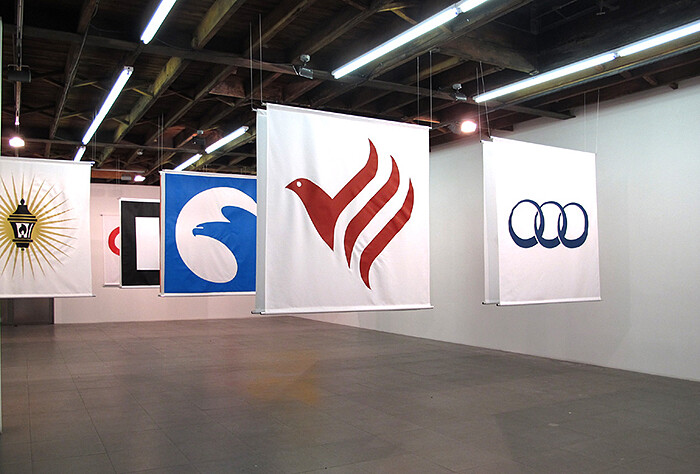Superflex, the Danish trio who famously installed a life-sized replica of JP Morgan Chase’s bathroom in a dumpy Lower East Side diner, has opened a comparatively sober exhibition at Peter Blum, stringing banners emblazoned with the logos of bankrupt banks throughout the gallery’s Chelsea location. Appropriately titled “Bankrupt Banks,” the exhibition continues the Danish group’s critiques of and investigations into financial markets and economic systems. Unwittingly and complacently fitting into the financial system that is the art world while critiquing those outside it, “Bankrupt Banks” packs a less fierce punch than the more socially conscious projects of the trio’s recent past.
For “Bankrupt Banks,” Superflex (Bjørnstjerne Christiansen, Jakob Fenger, and Rasmus Nielsen) hones in on the graphic design efforts of banks that either declared bankruptcy or were acquired by other banks. Work titles detail which retired bank owns the logo, which non-defunct bank they’ve been acquired by, and on what date, should one forget, Bankrupt Banks / Merrill Lynch acquired by Bank of America, September 14, 2008 (2012); Bankrupt Banks / BankWest acquired by Commonwealth Bank of Australia, October 9th, 2008 (2012), et cetera. Kaupthing, Colonial Bank, Washington Mutual, and Anglo Irish also make appearances. Originally created to communicate power, prestige, and success, these logos are ironically banded together with a hilariously deflating effect. Installed as 24 large banners in Blum’s industrial, white-cube space, the flag-like works appear at once as imposing and funereal, commercial and handmade—yet suspiciously market-ready.
Unclear here is the level of irony present in “Bankrupt Banks.” Walking into the space begets an uncanny feeling of willful misconception, with knowledge of previous projects flooding back, adding to a growing heap of confusion. Surely, the trio who brought us heating systems for third-world homes fueled by pig shit hasn’t implicitly sold out while examining the ranks of those who have. And although Superflex’s work is regularly infused with boyish, prank-inspired humor—rebuilding the interior of a McDonald’s just to flood it; attempting to hypnotize a British television audience during a Frieze-sponsored time slot on prime time national television—it shouldn’t be relegated to the likes of durr-quality sophomoric boy art which has annoyingly become a collector favorite. While there’s an essence to the oeuvre of Superflex that is at once catchy and lulzy, there’s also a true political ferocity, though its genuineness may be difficult to find, as is the case here.
A generous take on “Bankrupt Banks” would be that Superflex obliquely comments on the deflating and reinflating bubble of the art market, itself an economic system. Perhaps Superflex has presented us an exhibition that self-reflexively details the Chelsea status quo: lightly monumental, heavily critical, couched in some artistic rhetoric, utilizing outsourced production, installed cleanly in a clean white cube, etc., in order to delineate a system that itself is somewhat screwed up, and based on a market of vacant concepts and rules that ready it to collapse should its public gain consciousness of it. Yet, this doesn’t seem to be the case—neglecting to reach outside the hermetic context in which art is presented, as is the specialty of Superflex, “Bankrupt Banks” fails to convince.




